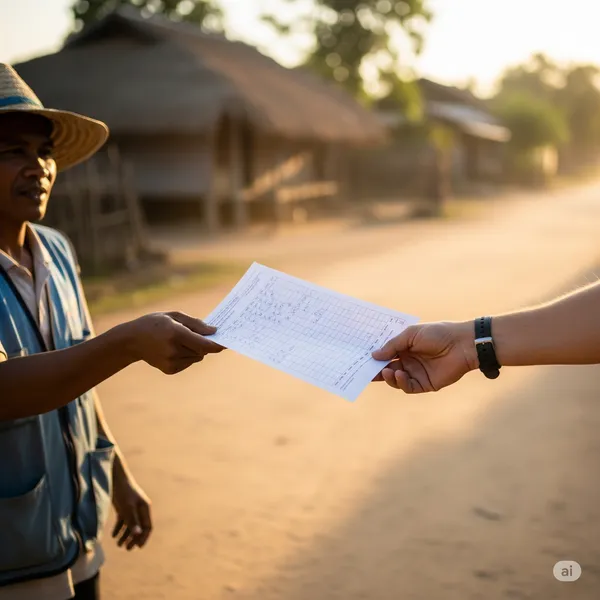De-risking Development with Integrated Monitoring
Published on: Thu May 15 2025 by Ivar Strand
De-risking Development: How Proactive Financial and Physical Monitoring Safeguards Investments
1. Introduction: The Fiduciary Imperative in Development Finance
International development partners and national governments invest billions of dollars annually in projects aimed at fostering stability and growth. These investments carry a significant fiduciary responsibility to ensure that funds are used for their intended purpose. However, in fragile, post-conflict, or otherwise challenging operating environments, the risks of fund diversion, fraud, and operational failure are acute.
The core challenge is twofold. First is the financial risk: that money is lost or diverted through weak controls or deliberate malfeasance. Second is the operational risk: that the physical assets, infrastructure, or services procured with those funds are never delivered, are of substandard quality, or fail to reach the intended beneficiaries. A conventional, retrospective audit-based approach is often insufficient to mitigate these risks in real time.
In this paper, we discuss a more robust approach: an integrated and proactive monitoring framework that combines rigorous financial tracking with systematic physical verification. This method provides donors and implementers with the assurance required to invest with confidence in high-risk contexts.
2. A Framework for Integrated Monitoring
A fundamental idea is that effective risk management requires a closed-loop system of accountability. It is not enough to simply track expenditures; one must also verify the tangible outcomes of that spending. Our approach is therefore built on two mutually reinforcing pillars:
- Financial Monitoring: This involves the forensic tracking of financial flows, from the donor’s initial transfer down to the final vendor or beneficiary. It is about following the money with a high degree of granularity.
- Physical Monitoring: This is the on-the-ground verification that the goods and services paid for have been delivered as specified. It is about “kicking the tires” to confirm that financial disbursements have translated into real-world assets and results.
At Abyrint, we have found that when these two functions are performed in isolation, critical risks are missed. A clean financial report can mask the fact that a school was never built. Conversely, a completed school building does not, by itself, prove that the funds were spent efficiently or without leakage. The synthesis of both data streams is what creates a powerful safeguarding mechanism.
3. The Practice of Financial Monitoring
Proactive financial monitoring goes beyond standard accounting. It is an investigative discipline aimed at identifying and flagging irregularities before they escalate into significant losses. The key activities include:
- Expenditure Verification: This is the process of tracing specific payments through the financial system to confirm they have reached the correct end recipient. It often involves scrutinizing bank records, payment orders, and receipts to ensure the entire transaction chain is sound.
- Payroll Integrity Checks: In contexts where payrolls for civil servants, police, or soldiers are a primary project expenditure, verifying the existence and eligibility of each individual on the list is critical. This prevents payments to “ghost” recipients—a common source of fiduciary leakage.
- Procurement Audits: This involves a systematic review of tender documents, supplier contracts, and invoicing. The objective is to ensure that procurement processes are competitive and transparent, and to identify potential conflicts of interest or collusive bidding patterns.
4. The Practice of Physical and Asset Monitoring
Physical monitoring provides the tangible proof that financial investments have yielded the contracted-for result. This is particularly crucial for capital-intensive projects involving construction and equipment procurement. The core components are:
- Asset Verification and Tagging: When equipment, vehicles, or other high-value assets are procured, each item should be assigned a unique identifier. Monitors then track these assets from the port of entry or warehouse to their final deployment location, ensuring they are not lost or diverted.
- Site Inspections: This requires trained personnel to visit project locations—often in environments that are not always permissive—to conduct structured assessments. An inspection verifies not only the existence of a facility, such as a clinic or a well, but also its adherence to technical specifications and operational status.
- Beneficiary Confirmation: For projects involving direct transfers of cash or in-kind goods, the final step is to confirm receipt with the intended beneficiaries. This can be done through sample-based surveys, interviews, or technology-enabled methods, providing a final, crucial check on the integrity of the delivery chain.
5. The Synthesis: Connecting Financial and Physical Data
The true value of this framework is realized when financial and physical data are analyzed in concert. A discrepancy between the two datasets is a clear and immediate red flag that warrants further investigation.
Consider a practical example:
- Financial Data: The project’s financial report shows a payment of $25,000 to a vendor for the delivery of 100 medical kits to a regional hospital. From a purely financial perspective, the transaction appears complete.
- Physical Data: A monitoring agent conducts an asset verification exercise at the hospital and confirms through inventory records and visual inspection that only 75 kits were received.
This mismatch immediately reveals a 25% delivery shortfall. Without the physical verification component, this loss would go unnoticed until, or unless, a much later audit uncovered it. This integrated approach creates a deterrent effect, as all parties become cognisant that both payments and deliveries are being actively monitored.
6. From Reactive Audits to Proactive Safeguards
For development partners operating in settings where institutional capacity is nascent and risks are high, relying on traditional, after-the-fact auditing is an inadequate safeguard. It identifies problems long after the funds have been lost and project timelines have been compromised.
A proactive system that integrates financial monitoring and physical verification changes the dynamic from reactive discovery to proactive risk management. It provides the timely, credible, and independent assurance needed to protect investments and ensure development objectives are met. This framework is not an additional administrative burden; it is a fundamental component of responsible and effective project execution.



